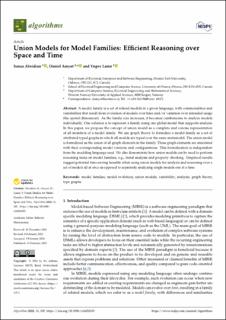| dc.contributor.author | Alwidian, Sanaa | |
| dc.contributor.author | Amyot, Daniel | |
| dc.contributor.author | Lamo, Yngve | |
| dc.date.accessioned | 2023-09-08T07:40:30Z | |
| dc.date.available | 2023-09-08T07:40:30Z | |
| dc.date.created | 2023-05-16T14:50:03Z | |
| dc.date.issued | 2023 | |
| dc.identifier.citation | Algorithms. 2023, 16 (2), . | en_US |
| dc.identifier.issn | 1999-4893 | |
| dc.identifier.uri | https://hdl.handle.net/11250/3088103 | |
| dc.description.abstract | A model family is a set of related models in a given language, with commonalities and variabilities that result from evolution of models over time and/or variation over intended usage (the spatial dimension). As the family size increases, it becomes cumbersome to analyze models individually. One solution is to represent a family using one global model that supports analysis. In this paper, we propose the concept of union model as a complete and concise representation of all members of a model family. We use graph theory to formalize a model family as a set of attributed typed graphs in which all models are typed over the same metamodel. The union model is formalized as the union of all graph elements in the family. These graph elements are annotated with their corresponding model versions and configurations. This formalization is independent from the modeling language used. We also demonstrate how union models can be used to perform reasoning tasks on model families, e.g., trend analysis and property checking. Empirical results suggest potential time-saving benefits when using union models for analysis and reasoning over a set of models all at once as opposed to separately analyzing single models one at a time. | en_US |
| dc.language.iso | eng | en_US |
| dc.publisher | MDPI | en_US |
| dc.rights | Navngivelse 4.0 Internasjonal | * |
| dc.rights.uri | http://creativecommons.org/licenses/by/4.0/deed.no | * |
| dc.title | Union Models for Model Families: Efficient Reasoning over Space and Time | en_US |
| dc.type | Peer reviewed | en_US |
| dc.type | Journal article | en_US |
| dc.description.version | publishedVersion | en_US |
| dc.rights.holder | © 2023 by the authors | en_US |
| dc.source.pagenumber | 34 | en_US |
| dc.source.volume | 16 | en_US |
| dc.source.journal | Algorithms | en_US |
| dc.source.issue | 2 | en_US |
| dc.identifier.doi | 10.3390/a16020105 | |
| dc.identifier.cristin | 2147888 | |
| dc.source.articlenumber | 105 | en_US |
| cristin.ispublished | true | |
| cristin.fulltext | original | |
| cristin.qualitycode | 1 | |

